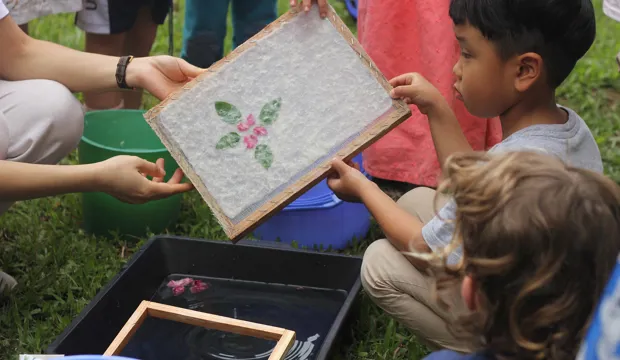
Recycling activities
Making a recycling centre at home
This exciting and educational activity is designed to empower students with a deeper understanding of recycling and inspire them to take positive actions at home. Students will delve into the world of recycling, discovering the importance of sustainable practices and their remarkable environmental impact.
As part of this journey, students will grasp the concept of recycling and embark on a creative endeavour to make their own recycling centre at home. Through hands-on learning and practical application, students will not just learn about recycling – they will actively contribute to a greener future by setting up a personalised recycling hub.
Activity introduction
In this resource, learners will participate in recycling activities and use the theme of National Earth Day to make a home recycling centre.
This activity could be used as a main lesson to teach learners about recycling, contributing to learning in science. It could also be used to introduce the different types of material, discuss the differences between their characteristics and develop skills in making graphic products in design & technology.
Moreover, this initiative holds the potential to ignite insightful conversations about the profound impact of waste materials on our global environment. It prompts contemplation on how these materials can be repurposed, generating novel substances and energy, and cultivating a sense of environmental responsibility among the participants.
What you will need
- Cardboard/Plastic boxes
- Sticky tape
- Glue sticks
- Scissors
- Coloured pencils
How long will this activity take?
This activity will take approximately 35-55 minutes to complete. Download the activity sheet below for a step-by-step guide on how to make your own recycling centre at home!
What is recycling?
Recycling is a fundamental environmental practice that involves collecting, processing, and transforming used or discarded materials into new products, thereby reducing the consumption of raw resources and minimising waste accumulation. It contributes to sustainability by conserving energy, reducing greenhouse gas emissions, and lessening the burden on landfills.
This cyclical process reprocesses items like paper, plastic, glass, and metal, extending their lifespan and lessening environmental impact. Recycling is crucial to a greener future, fostering responsible consumption and nurturing a circular economy that promotes resource efficiency and ecological harmony.
The engineering context
Modern society generates a significant amount of waste and garbage. Environmental engineers are responsible for managing waste disposal and recycling processes. For instance, paper waste is collected, cleaned, turned into pulp, and then repurposed to create fresh paper products.
Suggested learning outcomes
Upon completing this activity, students will have acquired knowledge about National Earth Day, comprehended the concept of recycling, gained insight into various recyclable materials, and developed the ability to recognise and categorise materials into suitable recycling bins.
Download the activity for free below
All activity sheets and supporting resources are free to download, and all the documents are fully editable so that you can tailor them to your students and your schools’ needs.
The activity sheet includes teacher notes, guidance, helpful web links, and links (where appropriate) to the national curriculum in the four devolved UK nations; England, Northern Ireland, Scotland and Wales.
Please share your classroom learning highlights with us @IETeducation





